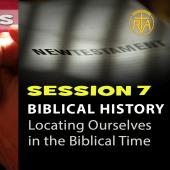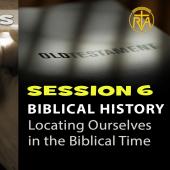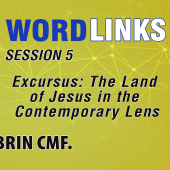WORDLINKS 2: The Task of Biblical Exegesis and its Pastoral Implications.
1. Exegesis is best thought of as a systematic way of interpreting a text. Everyone engages in exegesis in one form or another, but biblical exegesis has its own specialized needs and disciplines.
2. The goal of exegesis is to reach an informed understanding of the text. Here, one does an exegesis of a passage in which a coherent, informed interpretation is presented, based on one’s encounter with and investigation of a text at a given point of time. The immediate goal here is “understanding a text”, and then “establishing the meaning of a text”.
3. One way to think about the exegetical task is to interrogate or questions on the text. There are different kinds of questions we can put to a text; there are also different kinds of questions to ask for different purposes. In other words, there can be diverse approaches to the study of a text and diverse methods that can be employed to interrogate a text.
4. We can learn from modern theories of communication is the task of biblical interpretation. Modern communication theory has identified the different elements or factors involved in the communication process: (a)sender, (b)receiver, (c)the world of reality, (d)and signal.
(a) The sender represents the speaker, writer, artist, or whoever is the originator of communication.
(b) The receiver is the audience, listener, hearer, reader, or whoever becomes part of the particular communication process.
(c) The world of reality denotes the universe of objects, ideas, and meanings, which are shared in some way by both the sender and receiver and make communication possible.
(d) The signal is the means of communication; for the artist it is the work, for a writer it is the text.
5. If we apply this to biblical interpretation, the result would be like this: (a)originator(s), (b)audience(s), (c)universe of ideas and events, (d)biblical text.
(a) The originator(s) of the biblical text may be an author(s), an editor(s), a redactor, or the community.
(b) The audience(s) may be the original or subsequent hearers or readers.
(c) The universe of ideas is the shared world of thoughts, perspectives, and understandings that make communication possible and are mirrored and embodied in the text.
(d) The text is the medium of communication that may have originally been oral in form but moved to and now encounters us in written form.
6. Now, we can locate the various issues and problems or questions that we want to interrogate the text: whether the questions we ask focus on one or the other of the elements or factors of the communication process. We can now interrogate the text in terms of the author’s initial communication, the text’s (hypothetical) original shape, the original audience’s hearing, understanding, and reception, and so on.
7. Methods are the different techniques of interrogating the text. We call them “criticisms” because they allow us to enter into the text and do investigation. “Criticism” derives from the Greek word krinein, meaning “to judge” or “to discern,” and denotes the process through which discerning judgments are made. Methods, of course, carry with them limitations and problems. Methods are complementary; not exhaustive of the meaning of a text.
8. TEXTUAL CRITICISM: There exist textual variants. This fact leads us to wonder what the original wording or what the earliest form of particular reading might have been. Textual criticism deals with this problem.
9. HISTORICAL CRITICISM: Some questions have to do with the text’s setting in time and space – that is, its historical, geographical, and cultural setting or the context of the original author(s) and audience(s). Historical criticism deals with such questions.
10. GRAMMATICAL CRITICISM endeavors to answer questions pertaining to the language of the text: words or phrases; as well as the way in which the words are put together in sentence or paragraph. Rules of grammar in effect at the time the passage was written may also need to be examined if it appears that meaning and understanding depend upon resolving grammatical issues.
11. LITERARY CRITICISM concerns with the style, character, compositional techniques, and rhetorical patterns, among others: such as the location of a passage within larger literary units and how the passage functions within these larger units are often quite crucial in understanding and interpreting a text. Most of the biblical documents were originally oral in form or written to be read aloud. They were intended to persuade a listening audience. Ancient authors like ancient orators were usually intentional and careful about how they put together and arranged their story, speech or text. Thus, rhetorical features of a text are very important to consider.
12. FORM CRITICISM is concerned with the passage itself or with sub-units in a passage. Special attention is given to the literary form or genre of the passage: whether it is a parable, a prophetic speech, a hymn, among others. This is banking on the idea that form and meaning are closely related: one reads a poem differently from a prose. We find a rich diversity of forms in the Bible. Many of these already existed prior to their actual appearance in the biblical text. Hence, questions of the original setting of particular literary forms and genres are also crucial as one seeks to determine the “life situation” of a passage.
13. TRADITION CRITICISM seeks to uncover the earlier stages of development through which a text has undergone. Many of its parts of the, are like anthologies of sacred writings where revered stories, traditions, and sayings uttered by individuals and preserved by various communities have been collected, edited, and formed into a single text. This means that some texts have a “pre-history,” by which is meant that they were actually spoken or written, preserved and transmitted much earlier than their incorporation into the biblical text itself.
14. REDACTION CRITICISM focuses on the final form of the passage and on the changes or redactions it may have undergone in the editorial process. It assesses the significance of these editorial changes and reshapings, which may have occurred in the various written stages prior to and including its final form. The text we are dealing with is located within a specific biblical writing. The biblical author(s) or editor(s) may intend a passage to be understood in its final literary form.
15. STRUCTURAL CRITICISM seeks to explain how meaning is structured into a text. The biblical text, like any other, may be studied and interpreted purely as a text without regard its historical contexts like text’s origin and original audience. Such an approach focuses on the structure and meaning of the text.
16. CANONICAL CRITICISM explores how the Scriptures were transmitted and shaped by believing communities to produce a canon and how texts are to be read and understood as parts of a collection of sacred writings.
17. Although employing scientific tools and methods engaging with text, exegesis nevertheless an art as well as a science; it requires both imagination and creativity, not only in learning how to interrogate the text, but also in learning how to answer them and synthesizing these answers into coherent, meaningful interpretation of the passage. In engaging with biblical text, one can learn to be a scientist well as an artist.
18. Through the years of biblical studies, many and diverse methods have been introduced to understand the text. As these methods grow, our task of interpretation may also become so complicated. Until here, we are still dealing with text as an objective observer. We observe the text and its communication dynamics. There are methods that allow us to consider the active role of the reader of the text.
Continuation: Task of Biblical Interpretation and Pastoral Concern
Follow us at: https://www.facebook.com/wordlinks.claret/
Fr. Alex Gobrin cmf
Radio Veritas Asia (RVA), a media platform of the Catholic Church, aims to share Christ. RVA started in 1969 as a continental Catholic radio station to serve Asian countries in their respective local language, thus earning the tag “the Voice of Asian Christianity.” Responding to the emerging context, RVA embraced media platforms to connect with the global Asian audience via its 21 language websites and various social media platforms.
















- Reply
Permalink